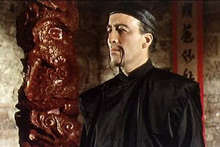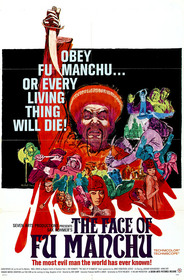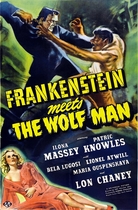Our editor-in-chief Nate Yapp is proud to have contributed to the new book Hidden Horror: A Celebration of 101 Underrated and Overlooked Fright Flicks, edited by Aaron Christensen. Another contributors include Anthony Timpone, B.J. Colangelo, Dave Alexander, Classic-Horror.com's own Robert C. Ring and John W. Bowen. Pick up a copy today from Amazon.com!
The Face of Fu Manchu (1965)
One's enjoyment of The Face of Fu Manchu depends on how highly one regards Saturday afternoon serials or at least the formula which made up those multi-chapter adventures. I am an unabashed fan of those old reel-to-reel cliffhangers: the cut-and-dried characters, the huge doses of action, and the simplified good-versus-evil plots. There's no significant subtext, characters in shades of gray, or convoluted writing to get in the way. The Face of Fu Manchu is perfect homage to those B-level time-fillers: stream-lined, stripped-down, "Boys' Life" derring-do at its best.
The film opens at a temple in China, where Dr. Fu Manchu (Christopher Lee) has been imprisoned and is awaiting execution by beheading. The order is carried out by the Chinese government and witnessed by, among others, Scotland Yard's Assistant Commissioner Sir Denis Nayland Smith (Nigel Green). The story skips ahead several months and changes the locale to London, which is being plagued by several bizarre strangulation murders. When Smith's associate and friend Dr. Petrie examines some fabric found around the neck of one of the victims, he discovers that it is a ceremonial scarf normally used by Dacoites, a cult with a history of obedience to Fu Manchu. Additionally, renowned scientist Professor Muller and his daughter Maria have disappeared. It becomes apparent to both Smith and Petrie that Fu Manchu has faked his own death and needs Muller to create a weapon to aid his plan of world domination.
To the film's benefit, director Don Sharp leans heavily on action set-pieces to propel the story over the occasional dull spot or plot hole. If you allow the viewer time to think about story, they'll see the logic gaps, lose interest, and then boredom sets in. Sharp's job is to make sure those credibility strains get overlooked by tossing in a big fight scene or chase every few minutes. No time to think about how it is that Fu Manchu has a lair in the sewer system under London's main river and no one knows about it. Forget that Smith, one of Scotland Yard's finest, is talking tactics on stopping Fu Manchu's plot within earshot of a lot of people in the lobby of the British Museum! The moment you start to think about those things, Sharp delivers a fight in the basement of the museum between Smith and a group of Dacoites or a frenetic car and plane chase. A lack of logic doesn't matter as long as fists fly or something blows up. With films like Devil-Ship Pirates (1964) or big Alistair Maclean epics like Puppet on a Chain (1971) and Bear Island (1979) to his credit, Sharp has always known how to make a cinematic thrill ride for fans.
 Christopher Lee in Don Sharp's The Face of Fu Manchu
Christopher Lee in Don Sharp's The Face of Fu ManchuScreenwriter Harry Alan Towers aids Sharp immensely by providing the right ingredients for a script in the Saturday matinee vein. There's a larger-than-life villain, desperate heroes, poison gas, scantily-clad women, strangulations, and torture. Nearly everything but the proverbial kitchen sink is thrown in. The dialogue is equally just broad enough and with just the right amount of silliness to fit in with the campy, tongue-in-cheek tone of the film. When Fu Manchu tests his lethal weapon on some Londoners in one scene, Dr. Petrie finds the bodies of one family at home seated at their dining table and riffs about them being killed during breakfast! Bits like that are good for a few chuckles and are perfectly in line with this type of camp adventure.
A veteran cast delivers the camp lines with aplomb, with a cool, reptilian Lee and a steel-eyed Green leading the pack. Lee uses an impassive face and slow, deliberate body movements to offer a Fu Manchu who is the essence of smooth, calculating evil, a chessmaster using the world as his board. Playing against him is Nigel Green as Nayland Smith, who matches Fu's intelligence with his own relentless determination. Green gives just the right stoicism to Smith, making him Scotland Yard's own lethal weapon against Fu Manchu.
Special commendation should also go to the film's art department, notably its director Frank White and costume supervisor Dorothy Edwards, who nicely recreate the atmosphere of 1920s London with a wide array of classic cars, clothing, props, and choice shooting location in London and County Gaol, Ireland. White and Edwards makes ingenious use of antique telephones, furniture and wireless communications sets to give the period an almost tangible quality here. From carefully detailed storefront exteriors to the style and color of the costumes, Edwards, White and company stretch their budget admirably in recreating the 1920s milieu.
Face of Fu Manchu is a highly entertaining thrill ride that crams fifteen chapters of story and action into one 89 minute movie. The next Saturday afternoon you have free, make some popcorn, plop yourself on the couch, and enjoy the fun as Nayland Smith battles Fu Manchu for the fate of the world, Sharp-style! It just might be the most action-filled, single chapter serial you'll ever see!








